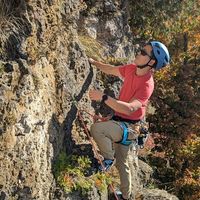#climbing self-belay devices tested, courtesy of HowNOT2.
-
#climbing auto-belay devices tested, courtesy of HowNOT2.
Amazed with that centrifugal brake design. It's really clever, simple and effective. Centrifugal clutches on motorbikes operate pretty much with the exact same principle using brake pad materials and rotation speed. I've always wondered how some of those auto-belay things worked internally.
I also think that centrifugal design is more serviceable if needed.
-
 D devnull moved this topic from Uncategorized on
D devnull moved this topic from Uncategorized on
-
#climbing auto-belay devices tested, courtesy of HowNOT2.
Amazed with that centrifugal brake design. It's really clever, simple and effective. Centrifugal clutches on motorbikes operate pretty much with the exact same principle using brake pad materials and rotation speed. I've always wondered how some of those auto-belay things worked internally.
I also think that centrifugal design is more serviceable if needed.
@rayko@mastodon.raykoworld.com there were a lot of defenders for the TruBlue in those video comments...! Namely in that the brake pads on the PD auto would wear out and thus presents a safety issue.
While true that the brake pads in the Perfect Descent would need regular replacing, I would imagine that the TruBlue folks would still advocate for regular servicing of their device, so either way you're looking at regular servicing.
Also really nice to see Bobby back on the channel!
-
@rayko@mastodon.raykoworld.com there were a lot of defenders for the TruBlue in those video comments...! Namely in that the brake pads on the PD auto would wear out and thus presents a safety issue.
While true that the brake pads in the Perfect Descent would need regular replacing, I would imagine that the TruBlue folks would still advocate for regular servicing of their device, so either way you're looking at regular servicing.
Also really nice to see Bobby back on the channel!
@devnull If you take this same principle of functioning, make the inner mechanism fixed in place, and attach a wheel to the outer shell to let rotate, you get a typical car drum brake.
The break pads in drum brakes last a very long time in a heavier load conditions. So I imagine the wear of auto-belay using that design should last quite a long time before servicing considering the lighter load it might have.
Making assumptions here though. And yeah, servicing would go to both regardless.